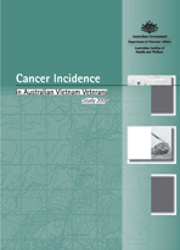Summary
Study initiation
A key recommendation of the 1997 Mortality of Vietnam Veterans: The Veteran Cohort Study was to monitor the mortality of Vietnam veterans and repeat the study after 2000. In 2002, the then Minister for Veterans' Affairs agreed that the Repatriation Commission should undertake the Third Vietnam Veterans Mortality Study and Cancer Incidence in Vietnam Veterans Study. The Commission asked the Australian Government Department of Veterans' Affairs (DVA) to conduct these studies which were undertaken with assistance from the Australian Institute of Health and Welfare (AIHW).
This report is the first of four volumes to be published and is the first investigation of cancer incidence for male Australian Vietnam veterans from all three branches of the armed forces - Navy, Army and Air Force. The number of females who served in Vietnam were too few for meaningful results in a study of this kind.
Study objectives
The objectives of the cancer incidence study were to:
- identify cases of cancer (excluding non-melanocytic skin cancers) among Vietnam veterans during the period 1982 to 2000 inclusive;
- compare the number of cases of cancer among Vietnam veterans with the number of expected cancers based on cancer incidence of the Australian community;
- report any differences in the cancer incidence for specific types of cancer, as highlighted by past studies and the literature review, from the Australian community;
- investigate any differences in cancer incidence between Navy, Army and Air Force Vietnam veterans;
- investigate any relationship between cancer incidence and exposure of Navy veterans to Vietnamese waters; and
- establish lists of personnel who served onboard HMA ships and Army small ships deployed to Vietnam and determine cancer incidence on a ship-by-ship basis.



